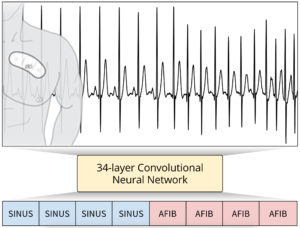An algorithm developed by researchers from the Stanford Machine Learning Group is able to detect arrhythmias better than certified cardiologists who specialize in the task. After a long process of training the model, it is able to diagnose the potentially deadly abnormal heart rhythms using electrocardiogram (ECG) signals collected from a continuous heart monitoring device manufactured by iRhythm Technologies.
“Having this technology that can tell you the condition of your heart, regardless of where you are, even if you’re not in the hospital constantly being monitored, provides a sense of security,” said Pranav Rajpurkar ’16, a second-year graduate student in the computer science department and co-lead author of the paper.
Arrhythmias can range in severity from requiring no treatment to being life-threatening and are often difficult to accurately diagnose. The diagnostic process can be time consuming, especially when looking through hours of data and also requires the expertise of trained cardiologists. Thus, the algorithm’s efficiency and accuracy in detecting and classifying arrhythmias as one of the 14 rhythm classes is a big step toward the goal of making affordable health care accessible to patients around the world.
“[The ECG] serves as a screening tool for heart-disease, so being able to automate what cardiologists can find in the signal can help us get this tool to people who don’t have it available,” said Awni Hannun, a computer science graduate student and co-lead author of the paper. “It can also help us automate a lot of the current workflow of doctors and technicians. This will free-up more time for them to work on tasks that the machine is not able to do.”

As reported by Stanford News, researchers were led by computer science professor Andrew Ng and worked in collaboration with iRhythm, a digital healthcare company founded by Uday Kumar, a Stanford Biodesign Innovation Fellow. Ng and his team collected and annotated over 60,000 records gathered from iRhythm’s Zio Patch, a heart monitor with a wearable electrode or a couple of electrodes that attach to the chest. That data was then fed into the learning algorithm after clinical ECG experts highlighted segments of the signal and marked it as corresponding to one of the 14 rhythm classes. The algorithm learnt over time which segments corresponded to which arrhythmias and eventually became adept at determining the sections with arrhythmias.
Teaching the model to ultimately perform successfully can often be a long process and is a common challenge in machine learning projects.
“The way that we overcame that [challenge] was by following a rapid iteration cycle of testing our ideas and prodding the system to see where it was not working well, and then using that analysis to guide our next steps. It led us for example to collect more examples of different types of arrhythmias, to change the length of the recordings and to make the convolutional network even deeper,” Hannun said.
The group asked a committee of three board-certified cardiologists to reach consensus diagnoses for a test set of over 300 records. Annotations were also collected from six individual cardiologists to compare the performance of the model to that of an individual. Finally, the researchers compared the results from the algorithm and the individual cardiologists to the consensus of the committee. They found that the model outperformed the individual cardiologist’s performance in most rhythms and had a higher overall success rate compared to individual physicians in accurately classifying and diagnosing arrhythmias.
Encouraged by the success of the model, the researchers are working to implement their algorithm in wearable heart monitors for anybody at risk of heart disease.
“If a cardiologist is not around, you can still buy a patch that goes on your chest and have it tell you whether something’s wrong with your heart,” Rajpurkar said. “This is especially useful in parts of the world where access to cardiologists is limited or expensive.”
A more long term goal, according to Hannun, would be a device that would not only constantly run algorithms but could contact emergency services if it found anything unusual or something extremely critical, like ventricular fibrillation. The group also hopes to take the machine learning experience and apply it to similar health care problems.
“I’m excited to see this [algorithm] being used,” Rajpurkar said. “In the future, there are a lot more areas where machine learning can be applied to medicine to make a large impact. Some of my focus is going to be on identifying what these high impact problems are and determining how to go about trying to solve the problem.”
Contact Eshani Mehta at eshani.mehta ‘at’ gmail.com.